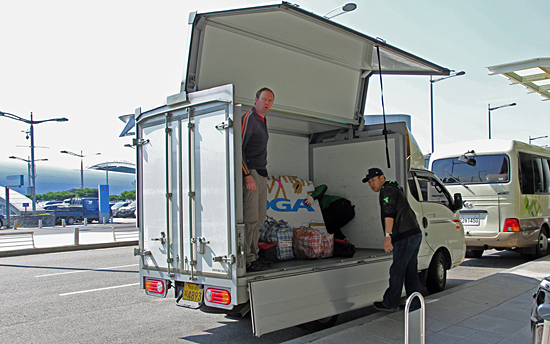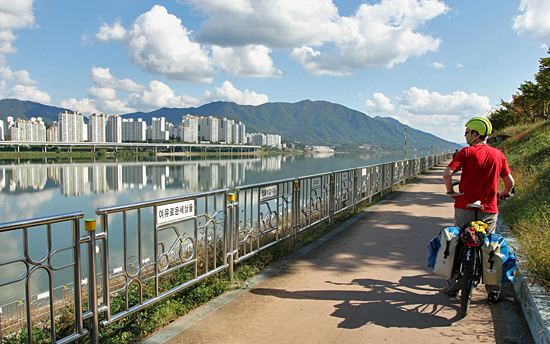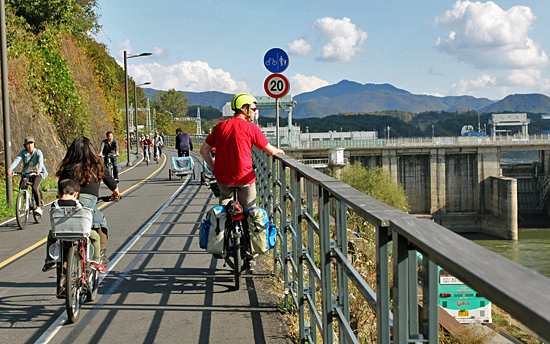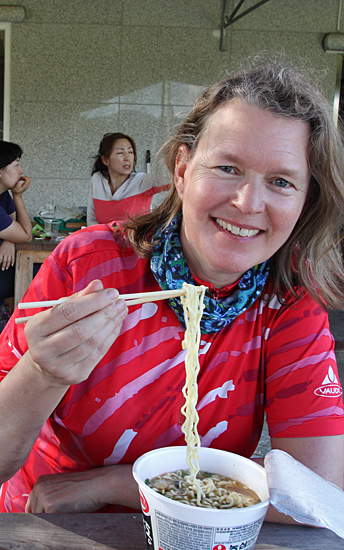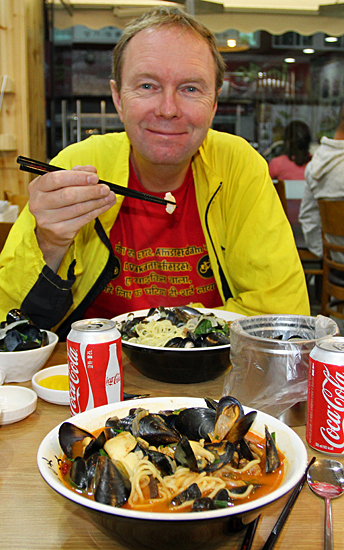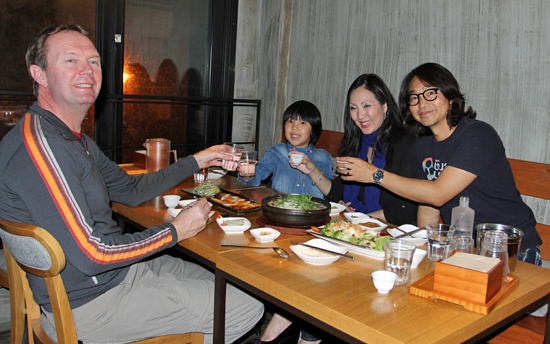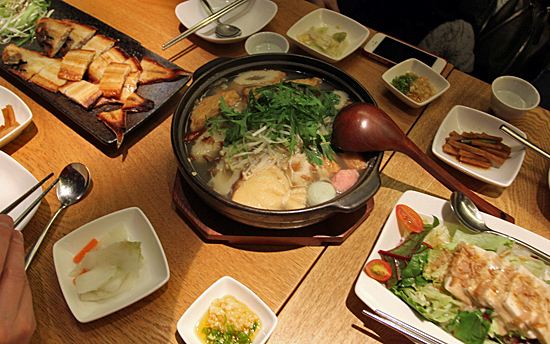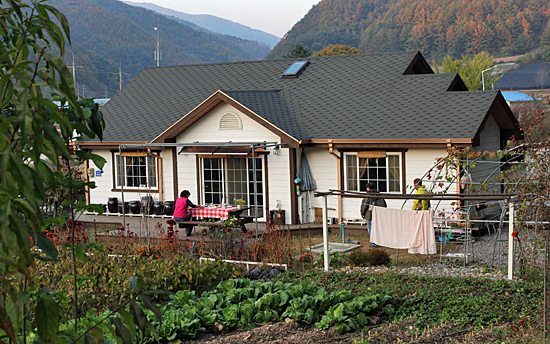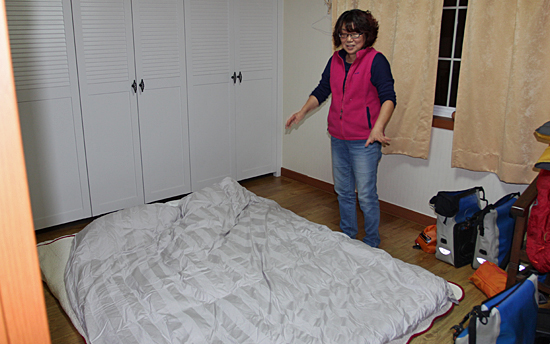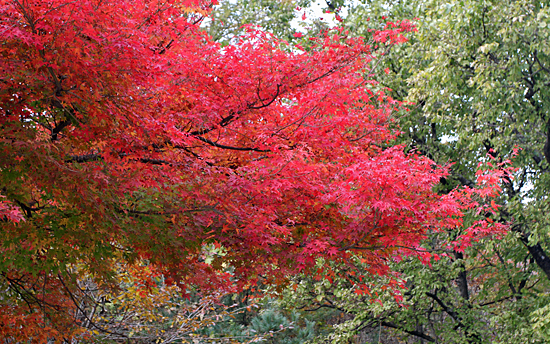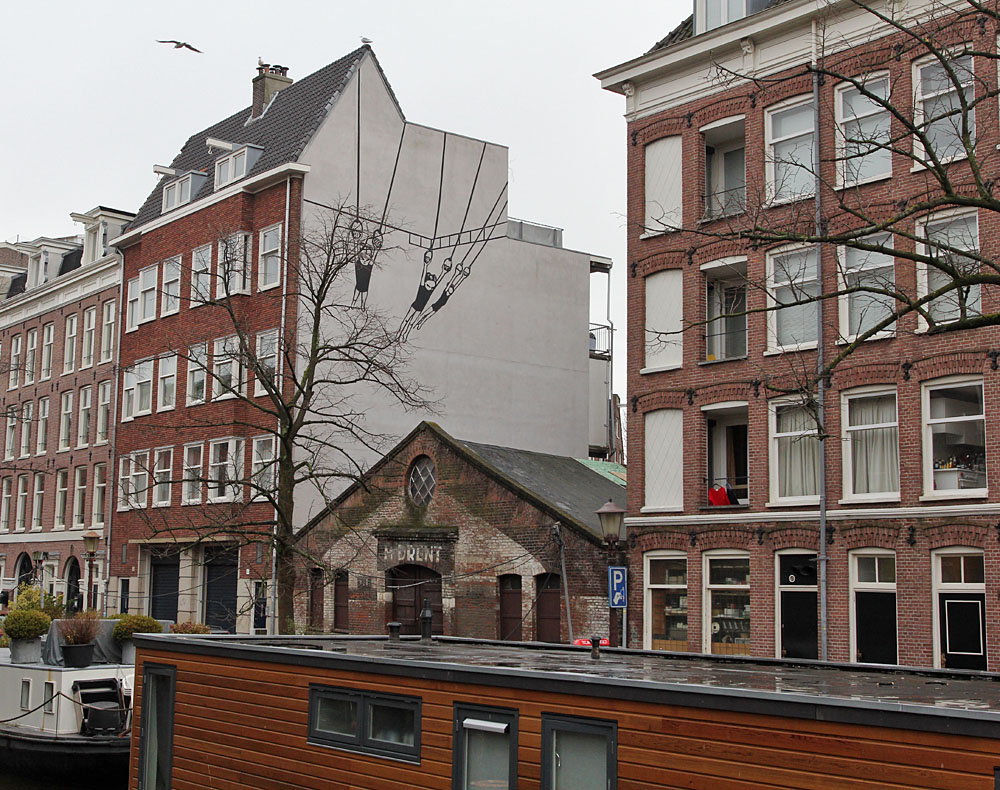 Hier rechts zie je een laag pand staan. Dat bevindt zich op de Lijnbaansgracht 61, om de hoek van De Vakantiefietser.
Hier rechts zie je een laag pand staan. Dat bevindt zich op de Lijnbaansgracht 61, om de hoek van De Vakantiefietser.
In dit pand komt een magazijn en een gastenkamer van De Vakantiefietser. Het zal ergens in februari 2014 klaar zijn.
De aannemer is dit pand nu aan het renoveren, dus eigenlijk kon ik nu niet weg omdat er beslissingen moeten worden genomen.
Maar ja, ik moet toch afstand nemen, dus gingen we op zoek naar het land met de hoogste internetcafé-dichtheid ter wereld. En dat is Zuid-Korea.
Zo kan ik iedere dag mijn mail lezen, PDF’s downloaden en skypen.
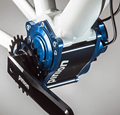
Uiteraard gaan we ook weer van alles testen.
Zoals de bijzonder mooie Koga Worldtraveller29 met Pinion versnellingsnaaf. We gaan hem nog wel naar wens aanpassen. Met nieuwe banden van Schwalbe een Brooks Cambium C17 zadel en Shimano Click’r pedalen.
Ik ga ook weer nieuwe schoenen testen en een Carrera helm, al hoop ik niet dat ik die daadwerkelijk nodig heb.
![]() On the picture above you see a low building. It is located on the Lijnbaansgracht 61, around the corner from De Vakantiefietser (The Holiday Biker).
On the picture above you see a low building. It is located on the Lijnbaansgracht 61, around the corner from De Vakantiefietser (The Holiday Biker).
This property is now being rebuilt as a warehouse and guest room for De Vakantiefietser. It will be ready sometime in February 2014.
The contractor is now renovating and building, so actually I could not go away now because a lot of decisions have to be made.
But yes, I have to get away sometime, so we went in search of the country with the highest Internet-density in the world. And that is South Korea.
So I can read my mail every day, download PDFs and skype.
Of course we are going to test a lot of things again.
For instance the particularly beautiful Koga Worldtraveller29 with the Pinion gear system. Of course we will adapt it to your liking. With new tires from Schwalbe, the Big Bens, a Brooks saddle and Shimano C17 Cambium Click’r pedals.
I will also be testing the new Ortlieb handlebar bag, some new shoes and a Carrera helmet, though I hope I do not actually have to need it :-).
Eric
For our non-Dutch speaking followers: you find the English translation after the Dutch.
We schreven het al eerder op deze website: zodra we het vliegtuig instappen voor weer een mooie fietstocht, voelen we ons als reizigers in de tijd. Het vliegtuig is voor ons een soort tijdmachine die ons het ene jaar twee decennia terug in de tijd zet en het volgende jaar soms wel een eeuw. Dit jaar, in Zuid-Korea, hebben we het gevoel dat we tien jaar vooruit in de tijd zijn gezet.
Het begint al direct op het perfect georganiseerde vliegveld. Feilloos en zonder lange wachtrijen bij de paspoortcontrole komen we na de irisscan en vingerafdruk het land binnen. Het is schoon en overzichtelijk. De fietsen worden keurig op een karretje aan ons overhandigd en we worden begeleid door de douane. Meestal worden onze fietsen in een hoek van de aankomsthal gedumpt en moeten we het zelf maar uitzoeken.
In deze toekomst staat iemand met een bordje met onze namen erop bij de uitgang te wachten en brengt ons naar de wachtende vrachttaxi. De chauffeurs mogen hun taxi niet verlaten en daarom is er een ophaler geregeld. De vrachttaxi kost tachtig Amerikaanse dollars voor een ritje van drieëndertig kilometer van het vliegveld naar ons hotel in Seoul.
Het hotel kost ons ook weer wat Amerikaanse dollars voor twee nachten.
De hotelkamer is meer dan prima. Er is een ligbad én een stoomdouche. Dat laatste hebben we nog niet meegemaakt en is dus voor ons een nieuwe, toekomst, ervaring. De toiletbril is verwarmd en aan de zijkant zitten een stuk of tien knopjes. In het Hangul -het Koreaanse schrift- staat erbij wat de knopjes beteken, maar ik waag mij er niet aan. De toekomst mag dan wel spannend zijn, maar kan misschien ook wel pijnlijk zijn.
We hebben vloerverwarming en airconditioning. Er staat een computer en er is Wi-Fi. Aan de wand hangt een enorme flatscreen tv, van Korea’s grootste merk; Samsung.
Ook op kleinere kamers die wij later betrekken hangt een joekel van een televisie. Zelfs zonder bril kan ik nog haarscherp zien!
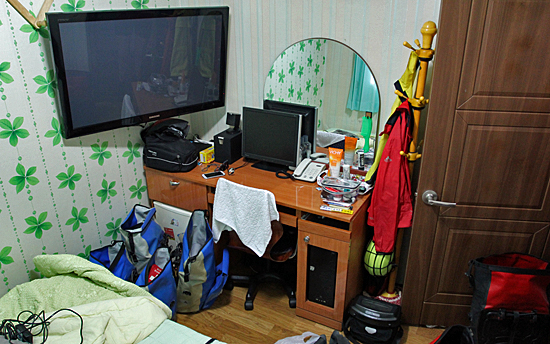
Bij veel hotels kunnen we onze fietsen parkeren op een parkeerplaats die van buitenaf niet te zien is. Lekker incognito dus. Door een klein schuifraampje spreekt een oudere dame in een roze pyama ons aan. Ze spreekt geen woord Engels en wij maar twee woorden Koreaans, dus dat schiet niet op. De App op mijn Samsung Galaxy zegt in vloeiend Koreaans: “Eén kamer alstublieft”. De dame wijst op de prijzen. We kunnen per uur of per nacht betalen. We kiezen voor het laatste.
We krijgen twee gesealde tandenborstels mee. Op de kamer is er tandpasta, scheercrème, drie flessen lotions, shampoo, douche gels in grote flacons, haarborstels, -kammen en haarlak, een föhn en een waterkoker. Onze bidons kunnen we in de lobby vullen met veilig drinkwater.
Een hotel voor nog geen drie tientjes in Danyang is helemaal superdeluxe. Op de kamer liggen twee brillen en er staat een grote 3D televisie, twee computers en een sierlijk zakje met verassingen: een gezichtsmasker, glijmiddel, één vrouwencondoom en twee herencondooms. Gezien het aantal condooms zou ik denken dat het een driepersoonskamer is, maar er hangen maar twee badjassen.
Oh ja, ik heb nog even in de laatjes van de nachtkastjes gekeken: geen bijbel te bekennen.
Waar we in andere Aziatische landen constant op onze hoede zijn voor kakkerlakken en ander ongedierte is dat –tot u toe- écht niet nodig. Alles is super schoon.
Seoul zelf is een zeer moderne stad met veel hoogbouw en een zeer uitgebreid metronetwerk en een nog uitgebreide Wi-Fi- netwerk. Zelfs het oudste oma-tje weet feilloos de vertaalapp te vinden waardoor we toch met haar kunnen communiceren.
De stad is schoon en wij ondervinden geen enkele luchtvervuiling van auto’s of bussen. De enige ‘luchtvervuiling’ zijn de geuren die uit de onnoemelijk vele eetgelegenheden komen.
Veel hoofdwegen, maar nog niet alle, hebben een fietsstrook. In ieder geval merk je dat men gewend is aan fietsers in het verkeer.
Na twee dagen acclimatiseren, fietsen we de stad uit langs de zuidoever van de rivier de Han. We fietsen bijna de hele dag over een super modern fietspad Seoul uit zonder ook maar één keer een autoweg te moeten oversteken.
Er zijn grote borden met uitgezette fietsroutes en paaltjes langs de route waarop het aantal kilometers van het fietspad staat aangegeven. Als je een beetje stijf bent geworden kun je op de een van de vele fitnessapparaten de spieren wat losser maken. Ook is er om de paar kilometer een koffie- of eettentje, of een Seven-Eleven-supermarktje waar wij yoghurtjes en brood kopen die wij op een van de vele picknick bankjes eten.

Maar in Zuid-Korea reis je soms toch ook een stukje terug in de tijd. De Koreanen houden van hun tradities zoals de hiërarchie die mannen boven vrouwen en oud boven jong stelt. En Koreanen slapen het liefst op dunne matjes op de grond. Maar dan weer wel met vloerverwarming.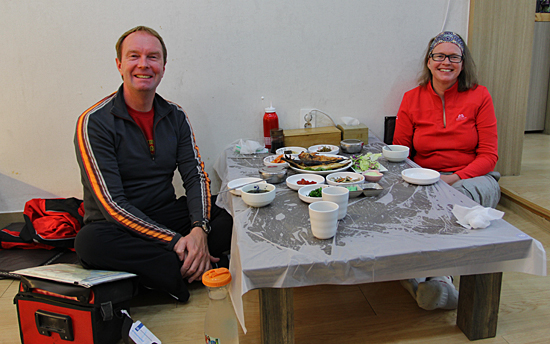
Er wordt nog steeds gegeten met stokjes, het liefst gezeten op kussentjes aan lage tafels. En het liefst zo heet mogelijk. De App leert ons dat we “Wea-um” moeten zegen en dan onze armen gekruist voor onze borst moeten houden. Dat werkt, maar helaas. Wat voor een Koreaan niet pittig is, is dat voor Eric nog wel.
![]() We wrote it before on this website: once we get on the plane for another wonderful bike trip, we feel like travelers in time. The plane is for us a kind of time machine that puts us back two decades some years and the following years sometimes a whole century. This year, in South Korea, we feel that we have been put a decade forward in time.
We wrote it before on this website: once we get on the plane for another wonderful bike trip, we feel like travelers in time. The plane is for us a kind of time machine that puts us back two decades some years and the following years sometimes a whole century. This year, in South Korea, we feel that we have been put a decade forward in time.
It starts straight away at the perfectly organized airport. Flawlessly and without long queues at passport control we are allowed into the country after the iris scan and fingerprint. It is clean and uncluttered. The bikes are neatly on a trolley handed to us and we are guided through the customs with them. Usually our bikes are dumped in a corner of the arrivals hall. We just have to figure it out ourselves.
In this future someone is waiting for us with a sign with our names on it at the exit and brings us to the waiting cargo taxi. Drivers may not leave their taxi and therefore there is a collector arranged. The freight taxi costs eighty U.S. dollars for a ride of thirty-three kilometers from the airport to our hotel in Seoul.
The hotel also costs us some U.S. dollars for two nights.
The hotel room is more than fine. There is a bathtub and steam shower. The latter we have not experienced and thus for us a new, future experience. The toilet seat is heated and on the side are a dozen buttons. In the Korean Hangul script it says what the buttons mean, so I do not dare to press one. The future may well be exciting, but can perhaps be painful.
There is under floor heating and air conditioning. There is a computer and Wi-Fi. On the wall hangs a huge flat screen TV, Korea’s largest brand, Samsung.
Also in smaller rooms that we stay in later is a whopper of a television. Even without glasses I can still see her sharp!
In many hotels we can park our bikes in a parking lot that is not visible from the outside. Nice incognito so. By a small sliding window an elderly lady in pink pajamas appeals to us. She speaks no English and we speak only two Korean words, so that is not much. The App on my Samsung Galaxy says in fluent Korean: “One room please”. The lady points to the prices. We can pay per hour or per night. We choose the latter.
We get two sealed toothbrushes. In the room there is toothpaste, shaving cream, three bottles of lotion, shampoos, shower gels in containers, hair brushes, combs , and hair spray , a hair dryer and a kettle . Our bottles we can fill in the lobby with safe drinking water.
A hotel for less than thirty dollars in Danyang is totally super deluxe . In the room there are two seats and there is a large 3D television, two computers and a dainty bag of surprises: a face mask, lubricant, one woman and two men condoms. Given the number of condoms I would think that it is a triple room, but there are only two bathrobes.
Oh yeah, I’ve had a look in the drawers of the side tables: no Holy Bible.
In other Asian countries we were constantly wary of cockroaches and other pests that which here – until now – you really do not need to worry about. Everything is super clean.
Seoul itself is a very modern city with high-rises, a very extensive metro network and an even more extensive Wi – Fi network. Even the oldest granny knows unerringly knows how to find the translation app on her smartphone so we can communicate.
The city is clean and we find no air pollution from cars or buses. The only ‘air pollution’ are the smells coming from the innumerable eateries.
Many main roads, but not all yet, have a bicycle lane. In any case, you will notice that one is accustomed to cyclists in the traffic.
After two days of acclimatization, we cycle out of town along the south bank of the Han River. We cycle almost the whole day on a super modern bicycle path out of Seoul without even once having to cross a motorway.
There are large signs with marked routes and poles along the route on which the mileage of the bike path is indicated. If you have become a little stiff, you can make use of the many exercise machines to ease the muscles. Also every few kilometers there is a coffee cafe, an eatery , or a Seven -Eleven supermarket where we buy yoghurts and bread that we eat on one of the many picnic benches.
But in South Korea you sometimes still travel a little bit back in time. The Koreans love their traditions like the hierarchy that men above women and old above young places. And Koreans prefer to sleep on thin mats on the floor. But then again: with under floor heating.
The Koreans still eat with chopsticks, preferably seated on cushions at low tables. And the food is preferably as hot as possible. The App teaches us that we must say: “Wea-um” and put our arms crossed in front of our chest, as we do not like it hot at all. That works, but, unfortunately, what is not spicy for a Korean is still for Eric.
For our non-Dutch speaking followers: you find the English translation after the Dutch.
In onze eerste week in Zuid-Korea hebben we een paar bijzondere ontmoetingen.
Ten eerste ontmoeten we mijn oud-collega’s van Philips Amsterdam, Ki en zijn vrouw Elaine, en hun zoontje. Eerder dit jaar zijn zij naar Seoul verhuisd omdat Helen daar een baan bij Philips aangeboden kreeg. Ki, van origine Koreaans, vond werk bij de concurrent Samsung.
Op onze tweede avond in Seoul nemen zij ons mee naar een restaurant waar we letterlijk een voorproefje krijgen van wat ons qua eten te wachten staat de komende weken. Veel vis en zeevruchten, maar vooral erg peperig. Ook toasten we veel met de Koreaanse rijstwijn die we overal tegen zullen komen. Prima spul!
De tweede bijzondere ontmoeting is met de twee Poolse fietsreizigers Aleksander en Karolina. Zij zijn zes maanden hiervoor uit Poznan vertrokken voor een tocht van een jaar door Rusland (ze wilden het Baikalmeer zien), Mongolië, China, Zuid-Korea, Japan, Taiwan, Indochina, Thailand en Maleisië. En dat allemaal op een Poolse tandem… Omdat het ze leuk leek voor de mensen in de landen die ze aandoen die nog nooit een tandem hebben gezien. Het geval heeft van origine maar één verzet, maar Aleksander heeft er een drie versnellingen Nexus naaf in gebouwd. De naaf is inmiddels hoognodig aan vervanging toe, dus dat hoopt hij hier of in Japan te doen.
Je kunt ze volgen op: www.inka-olo.pl of via hun Facebook pagina.
Ze reizen super low-budget, dus heeft Eric ze een goed avondmaal aangeboden en een hotelovernachting. Ze kamperen veel en het is ’s nachts op deze hoogte behoorlijk koud. Toch snapt Eric Aleksander niet. Hij heeft gestudeerd voor fysiotherapeut en heeft gewerkt als fietsenmaker. Beide roepingen ziet Eric geenszins terug in hun tocht: “Mmm, een beetje serieuze monteur was nooit op zo’n buigzame tandem met kleine wielen en een terugtraprem op wereldreis gegaan. En ze zitten ook nog eens totaal on-ergonomisch op de fiets.”
De derde bijzondere ontmoeting is met de ouders van mijn andere Koreaanse oud-collega van Philips Design, Da-mi. Toen we nog samenwerkten heb ik haar een keer gevraagd hoe het zou zijn om te fietsen in Zuid-Korea. Omdat we meestal wat later in het jaar en wat langer weggaan dan dit jaar, leek dat haar niet zo’n goed idee. Maar dit jaar zijn we wat eerder vertrokken en hebben we maar vier weken.
Toen ik haar onze plannen mailde kreeg ik binnen een dag een hele enthousiaste mail met allerlei tips, maar vooral dat we geen betere periode dan deze hadden kunnen kiezen. Dé perfecte tijd van het jaar. En ze had voor de zekerheid ook haar ouders vast geïnformeerd of wij, als we in de buurt zijn, langs kunnen komen. En ja hoor, het plaatsje ligt precies op onze route. We mailen twee dagen van te voren naar de ouders dat we inderdaad langs willen komen.
We worden met alle Koreaanse hartelijkheid en warmte ontvangen. We mogen zelfs blijven slapen. De moeder van Da-mi maakt een écht Koreaans bed voor ons en ’s morgens onthaalt ze ons op een heel bijzonder ontbijt, wat voor ons eigenlijk meer een avondmaaltijd is, maar ja, dan hadden we maar niet moeten vertellen dat we bijna elke ochtend op twee croissantjes en een cappuccino van de Paris Baquette of de Tous les Jours vertrekken. Zij vindt dat we daar niet zoveel uren op kunnen fietsen elke dag. Tja, ouders: altijd bezorgd, ook hier :-).
Carla
![]() In our first week in South Korea we have a few special encounters.
In our first week in South Korea we have a few special encounters.
First we meet up with my former colleagues from Philips Amsterdam, Ki and his wife Elaine, and their son. Earlier this year they moved to Seoul because Helen was offered a job with Philips there. Ki, Korean from origin, found a job with competitor Samsung.
On our second evening in Seoul they take us to a restaurant where we literally get a taste of what awaits us in terms of food in the coming weeks. Many fish and seafood, but most important: very spicy. We also toast a lot with the Korean rice wine that we will encounter. Good stuff!
The second special encounter is with the two Polish bicycle travelers Aleksander and Karolina . They left six months before we met them from Poznan for a tour of one year through Russia (they wanted to see Lake Baikal) , Mongolia , China , South Korea , Japan , Taiwan , Indochina , Thailand and Malaysia . And all this on a Polish tandem … Because they thought it would be nice for the people in the countries they visit who have never seen a tandem. The thing originally had only one gear but Aleksander built a three-speed Nexus hub in the back wheel. The hub is now in dire need of replacement, so he hopes to find one here or otherwise in Japan .
You can track them on: www.inka-olo.pl or through their Facebook page.
They travel super low budget, so Eric has offered them a good dinner and a hotel stay. They camp a lot and it is pretty cold at night at this altitude Yet Eric does not understand Aleksander. He studied physiotherapy and has worked as a bicycle mechanic . Both vocations Eric does not see in the way they travel: ” Mmm , a little serious mechanic would never had gone on a world trip on such a flexible tandem with small wheels and a coaster brake . And they are sitting totally un – ergonomic on the bike . ”
The third special meeting is with the parents of my other former Korean colleague of Philips Design, Da-mi .
When we were working together, I once asked her how it would be like to cycle in South Korea . Because we usually leave later in the year and go away longer than this year , it seemed not such a good idea at the time. But this year we left a little earlier and we have only four weeks.
When I e-mailed her our plans, within a day I got a very enthusiastic e-mail with all sorts of tips, but above all that we could not have chosen a better time than we had. Thé most perfect time of the year . And to be
sure she had informed her parents already to ask that, if we are in the area, we may come by. And yes, the town is right on our route.
We e-mail with two days’ notice to the parents that we really want to come by. We are welcomed with all the Korean cordiality and warmth. We may even stay for the night. The mother of Da-mi makes a real Korean bed for us and in the morning surprises us with a very special breakfast , which is actually to us an evening meal. Well, we should not have told them about the fact we almost every morning leave on two croissants and a cappuccino of Paris Baquette or Tous les Jours . She thinks we can not do so many hours cycling every day on a breakfast like that.
Well, that’s parents I guess: always concerned , here too :-).
Carla
For our non-Dutch speaking followers: you find the English translation after the Dutch.
Na een aantal passen en afdalingen bereiken we de kust. Door de Koreanen wordt de zee die voor ons ligt de “東海”genoemd, oftewel de Oostzee. Maar door de Japanners wordt dit de Japanse Zee genoemd. De 35 jaar bezetting door Japan heeft nog steeds haar naweeën.
We rijden langs de kust de havenplaats Jumunjin binnen. Vissersplaatsen zijn altijd leuk, zeker deze. Jumunjin lijkt wel een groot onderzee-aquarium. Voor de restaurants aan de kade staan grote glazen waterbassins met een krioelende massa aan krabben.
 Niet van die kleintjes, maar echte joekels. En niet één soort, nee in alle soorten en kleuren: van geel tot oranje en van bruin tot groen. Vooral van dichtbij zien ze er buitenaards uit, een beetje als de buitenaardse wezens uit de geweldige film District 9.
Niet van die kleintjes, maar echte joekels. En niet één soort, nee in alle soorten en kleuren: van geel tot oranje en van bruin tot groen. Vooral van dichtbij zien ze er buitenaards uit, een beetje als de buitenaardse wezens uit de geweldige film District 9.
Een groepje Koreanen kiest drie krabben uit. Routineus hengelt het ‘viswijf’ de krabben met een pikhaak uit de bak en legt ze op hun kop op een weegschaal. Daarna belanden ze in een pan kokend water. Auw!
“Carla, kunnen krabben pijn voelen?”
“Ik weet het niet, maar ik vind het wel zielig.”
In andere glazen bassins herken ik een paar vissen van de visboer: makreel, tong en schol. Die laatste worden platvissen genoemd en geheel naar verwachting liggen die plat op de bodem. Daarboven zwemmen pijlinktvissen, wat karperachtigen en vissen die ik ken van televisieprogramma’s: steenvissen en koraalvissen. Carla is een kenner: “Als je die verkeerd bereidt kun je eraan doodgaan.”
In plastic bakken zitten mosselen en oesters. En in weer een ander aquarium kreeften. Die zitten als enige van de groep schaarachtigen met de poten vastgebonden. De grote octopussen krijgen ook een voorkeursbehandeling; ze zitten in isolement en hebben ieder een eigen teiltje.
Het bijzondere is dat al die zeedieren gevangen worden en levend aan wal worden gebracht. En nee, het zijn niet een paar bakken maar bij elkaar zijn het er tientallen, misschien wel honderden.
Bij andere winkels liggen en hangen gedroogde vissen. Van grote roggen tot piepkleine zilvervisjes. Die laatsten krijgen we te eten in een van de restaurants. Ze zijn gedroogd in de zon met als resultaat een stevige bite. Zo hypocriet als ik ben vind ik het raar om zo’n visje compleet met de schattige ronde zwarte oogjes naar binnen te kauwen. Carla vind het op haar beurt wat vreemd als ik bij een restaurant aanwijs welke levende tong ik wil hebben. Ze wil het niet zien, maar wel eten.
We proberen de kok duidelijk te maken dat we hem gebakken willen hebben, maar dat past niet in zijn systeem. Als we de tong opgediend krijgen is het tong-Sashimi, oftewel rauwe tong, keurig schoongemaakt, gefileerd en in rolletjes op een bordje neergelegd. Wij wijzen nogmaals op de foto met de gebakken vissen en het kwartje (ongeveer 300 Wong) valt. Tja, blijkbaar stuit het tegen zijn Koreaanse borst om verse vis te bakken. We krijgen nog een gebakken makreel ernaast, een soort van atjar tjampoer, soep en rijst. Oh ja, we eten met roestvrijstalen stokjes en gehurkt achter een lage tafel.
Eric
Oh ja, meer over een bijzondere soort vissen (de Aquoreanen) in mijn volgend stukje.
![]() After several passes and descents we reach the coast. The Koreans call the sea that lies in front of us the “东海”, or the East Sea. But this sea is called the Sea of Japan by the Japanese. The 35- year occupation by Japan still has its aftermath.
After several passes and descents we reach the coast. The Koreans call the sea that lies in front of us the “东海”, or the East Sea. But this sea is called the Sea of Japan by the Japanese. The 35- year occupation by Japan still has its aftermath.
We ride along the coast to the port of Jumunjin. Fishing towns are always fun, especially this one. Jumunjin looks like a large undersea aquarium. In front of the quayside restaurants are large glass basins with a teeming mass of crabs .
And not little ones, no, real whoppers . And not only one kind, no, in all shapes and colors, from yellow to orange and brown to green. Especially up close they look like aliens, a little like the aliens from the great movie District 9.
A group of Koreans choose from three crabs. With a smooth routine the ‘ fishwife ‘ angles the crabs with a hook out of the basin and put them upside down on a scale . Then they end up in a pan of boiling water. Ouch !
” Carla, can crabs feel pain ? ”
” I do not know, but I think it’s a bit pathetic. ”
In other glass basins I recognize a few fish of my fishmonger: mackerel, sole and plaice. The latter are called flatfish and fully expected they lie flat on the bottom. In the same basin we see squid, carp like fish and fish that I know from television programs: stone fish and coral fish. Carla is a connoisseur: “If you prepare these wrong you can die”.
In plastic bins sit mussels and oysters. And in yet another aquarium lobsters. They’re the only one of the scissor -like group that have their legs tied. The large octopuses also receive preferential treatment they are in isolation and have their own basin.

The remarkable thing is that all these sea creatures are caught and brought ashore alive. And no, it’s not some basins, but all together there are dozens, perhaps hundreds .
In other shops hang dried fish. From large rays to tiny silverfish. The latter we get to eat at one of the restaurants. They are dried in the sun, resulting in a firm bite. Hypocritical as I am I find it strange to eat such a fish complete with the cute round black eyes. Carla finds it at her turn strange when I indicate at a restaurant the living sole I want to eat. She does not want to see it , only eat it.
We try to make clear to the cook that we like the sole fried, but that clearly does not fit into his system. When we see the sole back it has turned into sashimi , raw sole , neatly cleaned , filleted and nicely deposited on a plate. We point out to the fried fish in the picture and the penny ( about 300 Wong ) drops. Well , apparently it jars with him, therefore, to bake fresh fish. We finally make it clear we want a fried sole and get a fried mackerel next to it, a kind of relish, soup and rice . Oh yeah , we eat with stainless steel chopsticks and crouched behind a low table .
Eric
Oh yeah, my next article is about a special kind of fish – Aquoreanen.
For our non-Dutch speaking followers: you find the English translation after the Dutch.
Vissen zwemmen vaak in groepen en als we ze zien, zwemmen ze meestal in een kunstmatig aquarium. Korea heeft wel wat weg van een groot aquarium. Bij de beroemde Wiljeongsa tempel staan tientallen bussen waar scholen Koreanen uitstromen als sardientjes uit een blik. Ze volgen de leidstervis die met haar paraplu omhoog voor de groep uitloopt. Als ik iemand wat vraag, hapt hij als een vis naar lucht. Nee, de meeste Koreanen spreken geen woord Engels. Met grote ronde ogen kijkt hij mij aan en vlucht het liefst weg in de school Koreanen.
Koreanen hebben ook wel wat weg van oesters. Als je ze benadert, dan klappen ze dicht.
“Do you speak English?” En of ze het nu wel of niet spreken ze blijven je aankijken als een vis op het droge. Na het eerste contact gaan de oesters dan wel weer open.
De vis wordt duur betaald, want het reizen op deze manier is niet erg makkelijk en eigenlijk ook niet leuk. Koreanen lijken wat afstandelijk en lijken weinig levensvreugde te hebben. Collega’s onder elkaar zie ik nooit grapjes met elkaar maken. Zwijgend doen ze hun werk en doen precies datgene wat hun positie vereist. Ze lijken op te gaan in een school haringen en gaan voor het collectief. Alhoewel: in een karaokebar gaan ze uit hun bol. Ze zijn dan zo stoned als een garnaal, zingen uit volle borst en slaan nog een lokaal Cass-biertje achterover.
En dan is het net alsof ze graag in een groot aquarium rondzwemmen met allerlei prullaria erin. Petit France is een verzameling Franse huisjes tegen een berghelling aangebouwd: een top toeristische attractie. Busladingen Koreanen snuiven even de Franse geur op en hup, weer terug in de bus naar de volgende.
In Andong wil Carla graag naar de langste houten loopbrug van Korea. Daar komen we voor het eerst in anderhalve week westerse kuddetoeristen tegen die ook in deze toeristen-fuik zijn gezwommen. De brug over de Nakdong rivier is recent gebouwd. Betonnen pilaren zijn met mooie stalen spanten met elkaar verbonden waarop een pittoreske houten brug, inclusief Koreaans aquarium-huisje, is gebouwd.
De meeste attracties zijn sowieso voor de Koreanen en voor het binnen-aquoreaans toerisme bedoeld. Borden hebben soms een Engelstalige kop, maar de rest is het Hangul. Ook de dames van VVV happen naar adem als wij binnenkomen.
Maar toch, we hebben een nacht bij mijnheer en mevrouw Byun geslapen. We werden erg verwend en ik voelde mij als een vis in het water.
Ach, ik denk dat ik nog even een paar weken hier moet rondfietsen voordat ik aan de Koreanen en de Koreaanse manieren gewend ben. Maar voor nu voel ik mijzelf een beetje als een vis op het droge.
Eric
![]() I wrote this story in Dutch with many typical Dutch expressions which are very hard to translate, but let’s give it a go…
I wrote this story in Dutch with many typical Dutch expressions which are very hard to translate, but let’s give it a go…
Fish often swim in groups and as we see them, they usually swim in an artificial aquarium. Korea sometimes looks like a large aquarium. At the famous Wiljeongsa temple are dozens of buses where schools of Koreans emerge as sardines from a can. They follow the guide fish culminating with her umbrella up for the group. If I ask someone what he gasps for air like a fish. No, most Koreans do not speak a word of English. With large round eyes, he looks at me and prefers to flee into the school of Koreans.
Koreans also look a bit like oysters. If you approach them, they close their shell.
” Do you speak English?” And whether or not they can speak English, they look at you like a fish on dry soil. After the first contact the oyster will open though.
The fish is paid expensive, because traveling this way is not very easy and really not so much fun. Koreans seem a bit aloof and seem to have not much joy in life. I never see colleagues make jokes and laugh with each other. Silently they do their job and do exactly what their position requires so it seems. They seem to go up into a school of herring and go for the collective. Although: in a karaoke bar they go out of their minds. They are as high as a kite, singing lustily and have too much local Cass beer.
And it’s like Koreans like swimming around in a big aquarium with all kinds of odds and ends in it. Petit France is a collection of French cottages built on a hillside: a top tourist attraction. Busloads of Koreans just sniffing the scent of French and wham, back on the bus to the next made up attraction.
In Andong Carla wants to see the longest wooden footbridge of Korea. For the first time in one and a half week we run into a flock of western tourists that have also swum into this tourist trap. The footbridge over the Nakdong River is newly constructed. Concrete pillars with beautiful steel trusses on which this picturesque wooden bridge, including Korean aquarium house, was built.
Most attractions are anyway intended for the Koreans and the local Aquorean tourism. Signs sometimes have an English head, but the rest is the Hangul language. Also the ladies of the tourist information center are gasping for breath as we enter.
Yet, we slept at Mr. and Mrs. Byun’s residence. We were very spoiled and I felt like a fish in the water.
Oh well, I guess I just have to cycle around for a few more weeks before I’m accustomed to the Koreans and the Korean ways. But for now I feel a bit like a fish out of water.
Eric

For our non-Dutch speaking followers: you find the English translation after the Dutch.
Het kwam toevallig zo uit, maar de mooiste tijd van het jaar om in Zuid-Korea te zijn is de herfst. Het is niet meer zo warm en de winter lijkt nog ver weg. Er heerst een soort van Indian Summer, een rustig weertype dat ervoor zorgt dat de kleurende blaadjes aan de bomen er niet zo snel af waaien. Aangezien 70% van Korea bedekt is met vooral loof bos, geeft dat een prachtig gezicht als al die bomen knal geel, oranje en rood kleuren.
Vooral wandelen in de nationale parken, zoals het Seorak Nationale park, is dan erg in trek bij de Koreanen. Het bos is opeens een enorme toeristische attractie geworden. Opeens begrepen we dan ook de vele buitensportwinkels in het Dongdaemun marktgebied in Seoul.
![]() It just so happened, but the most wonderful time of the year to be in South Korea is autumn. It is not so hot and the winter seems far away. There is a kind of Indian Summer, a calm type of weather that makes that the coloring leaves on the trees are not blown off so quickly. Since 70% of Korea is covered with mostly deciduous forest, it is a beautiful sight when all those trees color bright yellow, orange and red.
It just so happened, but the most wonderful time of the year to be in South Korea is autumn. It is not so hot and the winter seems far away. There is a kind of Indian Summer, a calm type of weather that makes that the coloring leaves on the trees are not blown off so quickly. Since 70% of Korea is covered with mostly deciduous forest, it is a beautiful sight when all those trees color bright yellow, orange and red.
Especially hiking in the national parks, such as the Seorak National Park, is very popular with the Koreans. The forest has suddenly become a huge tourist attraction. Suddenly we understood the huge amount of outdoor shops in the Dongdaemun market area in Seoul.
He Eric en Carla,
Vergeet niet Gyeongju aan te doen. Jaren geleden geweest en erg mooi.
Groetjes Gerben
———————————————
Hoi Gerben,
nou, eerst waren we in Jyeongju maar dat bleek toch een andere stad te zijn terwijl het maar een letter scheelt.
Dus zijn we doorgefietst naar Gyeongju. Je kunt daar goed zien wat er gebeurt als je olifanten met mollen kruist: hele grote molshopen.
Maar volgens Carla had het iets te maken met koningen die daar begraven zijn.
Sowieso is het een leuke stad. Speciaal voor jouw dochter Asha.
’s Avonds worden er plaatjes geplakt op de deur van het hotel en dan kun je een nummer bellen voor een fruithapje. Een perzik, een trosje druiven of een banaantje.
De hotelkamer is van alle kindergemakken voorzien: er waren maar liefst twee soorten ballonnen. Jongetjes- en meisjesballonnen. En Gerben, als je bang bent voor schadelijke bacillen bij het opblazen, dan is er een ook een zakje met een soort van sinaasappelsaus dat bacteriedodend werkt. Dus dank voor jouw tip!
Eric
